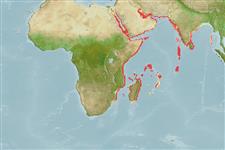>
Eupercaria/misc (Various families in series Eupercaria) >
Lethrinidae (Emperors or scavengers) > Lethrininae
Etymology: Lethrinus: Greek, lethrinia, a fish pertaining to genus Pagellus.
More on author: Valenciennes.
Environment: milieu / climate zone / depth range / distribution range
Écologie
marin récifal; non migrateur; profondeur ? - 40 m (Ref. 9710). Tropical; 30°N - 30°S, 33°E - 93°E
Indian Ocean: including the Red Sea and the Persian Gulf south to Durban, South Africa, then east to North Bay Reef, Andaman and Nicobar Islands. Reports of this species elsewhere are probably due to misidentification.
Length at first maturity / Taille / Poids / Âge
Maturity: Lm 21.3 range ? - ? cm
Max length : 40.0 cm TL mâle / non sexé; (Ref. 2295); common length : 25.0 cm TL mâle / non sexé; (Ref. 2295)
Épines dorsales (Total): 10; Rayons mous dorsaux (Total): 9; Épines anales 3; Rayons mous anaux: 8. The inner surface of the pectoral fin base is densely scaled; posterior angle of the operculum is fully scaled; cheeks without scales. Color of body is dark gray or yellow-brown, head is brown-gray. The centers of scales are lighter. Sometimes there is an irregular pattern of broken dusky bars becoming whitish on the lower part of the body. The pectoral and pelvic fins are white of pinkish. The dorsal and anal fins are mottled white or yellowish with reddish edge. The caudal fin has indistinct reddish bands.
Found in sandy areas near reefs during daytime, sometimes in small groups. At night, they are solitary and range over reef-flats and slopes where they feed primarily on echinoderms, mollusks and crustaceans (Ref. 2295). The taxonomy of this species has been considerably confused.
Life cycle and mating behavior
Maturité | Reproduction | Frai | Œufs | Fécondité | Larves
Exhibits juvenile hermaphroditism (Ref. 107020).
Carpenter, K.E. and G.R. Allen, 1989. FAO Species Catalogue. Vol. 9. Emperor fishes and large-eye breams of the world (family Lethrinidae). An annotated and illustrated catalogue of lethrinid species known to date. FAO Fish. Synop. 125(9):118 p. Rome: FAO. (Ref. 2295)
Statut dans la liste rouge de l'IUCN (Ref. 130435)
Menace pour l'homme
Harmless
Utilisations par l'homme
Pêcheries: intérêt commercial mineur
Plus d'informations
RéférencesAquacultureProfil d'aquacultureSouchesGénétiqueElectrophoresesHéritabilitéPathologiesTraitementNutrientsMass conversion
CollaborateursImagesStamps, Coins Misc.SonsCiguateraVitesseType de nageSurface branchialeOtolithesCerveauxVision
Outils
Articles particuliers
Télécharger en XML
Sources Internet
Estimates based on models
Preferred temperature (Ref.
123201): 25.5 - 29.2, mean 27.2 °C (based on 250 cells).
Phylogenetic diversity index (Ref.
82804): PD
50 = 0.5000 [Uniqueness, from 0.5 = low to 2.0 = high].
Bayesian length-weight: a=0.01514 (0.00706 - 0.03245), b=2.98 (2.81 - 3.15), in cm total length, based on LWR estimates for this Genus-body shape (Ref.
93245).
Niveau trophique (Ref.
69278): 3.5 ±0.41 se; based on food items.
Résilience (Ref.
120179): Haut, temps minimum de doublement de population inférieur à 15 mois (Preliminary K or Fecundity.).
Fishing Vulnerability (Ref.
59153): Low vulnerability (23 of 100).
Climate Vulnerability (Ref.
125649): High to very high vulnerability (68 of 100).
Nutrients (Ref.
124155): Calcium = 62.6 [43.1, 100.3] mg/100g; Iron = 1.08 [0.69, 1.62] mg/100g; Protein = 20.3 [17.7, 22.5] %; Omega3 = 0.13 [0.09, 0.19] g/100g; Selenium = 45.4 [27.9, 78.8] μg/100g; VitaminA = 21 [4, 115] μg/100g; Zinc = 2.38 [1.76, 3.14] mg/100g (wet weight);
